

In a historical sense, Chicago’s reputation is that of a rough, no-nonsense city where people roll up their sleeves and get to work -- A city where the rubber is quick to meet the road. Tristan Meinecke’s oeuvre has great synergy with this ethos. He was an iconoclast and a rebel, but his artistic and personal defiance was substantive, arising from an overpowering need to know and to create in whatever way the creative work itself demanded. He actively rejected participation in the formal art world, but this rejection was in no way superficial — though the actual process of being contrarian did give him savage delight. Rather, Meinecke recognized that conforming to the arbitrary expectations imposed by a social power structure would have diminished his ability to express his own vision, to seek artistic truth on his own terms which to him, anything less, would have been intolerable. The exhibition at Tapestry Center offers a rare opportunity to see select works from Tristan Meinecke in an intimate and personal setting. |
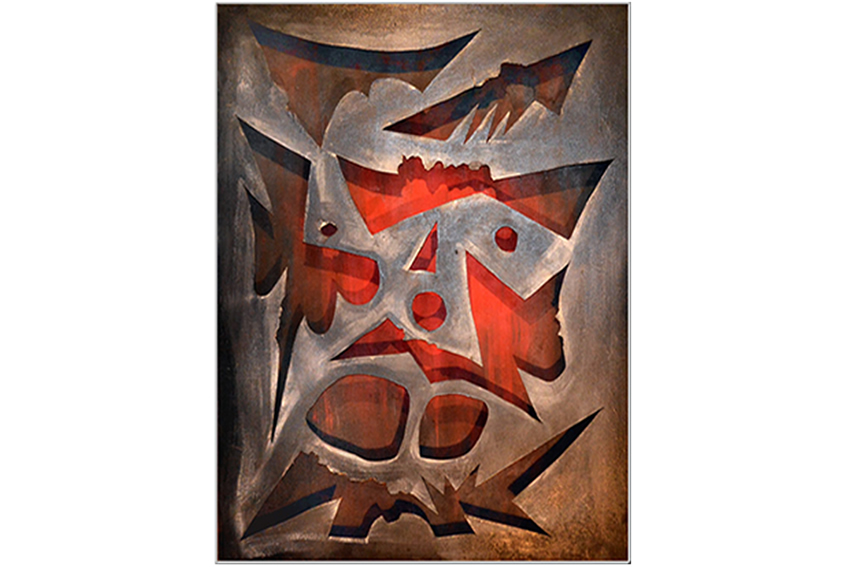
This painting is best introduced by a quote from Franklin Rosemont’s -- Revolution in the Service of the Marvelous: “Versatile in his handling of light, as in everything else, Meinecke is primarily an artist of the night. No stranger to ecstasy, he is also a great brooder, and melancholy has not been the rarest of his moods. Not surprisingly, his many distinctly noir paintings are among his best. The vivid, hard-hitting “Open Rebellion,” in which even the shadows seem to cast shadows, recalls the sultry nocturnal lyricism of such David Goodis tales as Dark Passage or Nightfall.” (p.76)
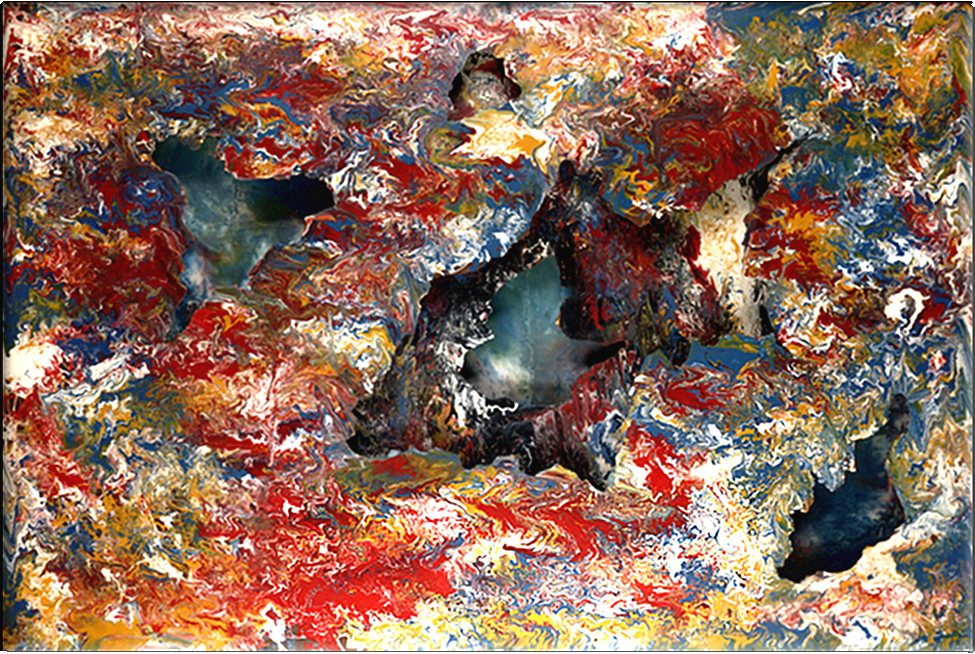
A mesmerizing feast for the eyes, “Burning with Awareness” also represents a pinnacle of technical prowess which required a great deal of practical knowledge to even attempt. One interpretation of this work is a liminal exploration of the ego-dissolving ecstasy of the act of creation. The cauldron of infinite potential explodes, shattering even itself, condensing further and further until it touches an un-looked for serenity in the heart of chaos — a gnostic union of creator and created, unadulterated immanent knowledge of the thing itself.
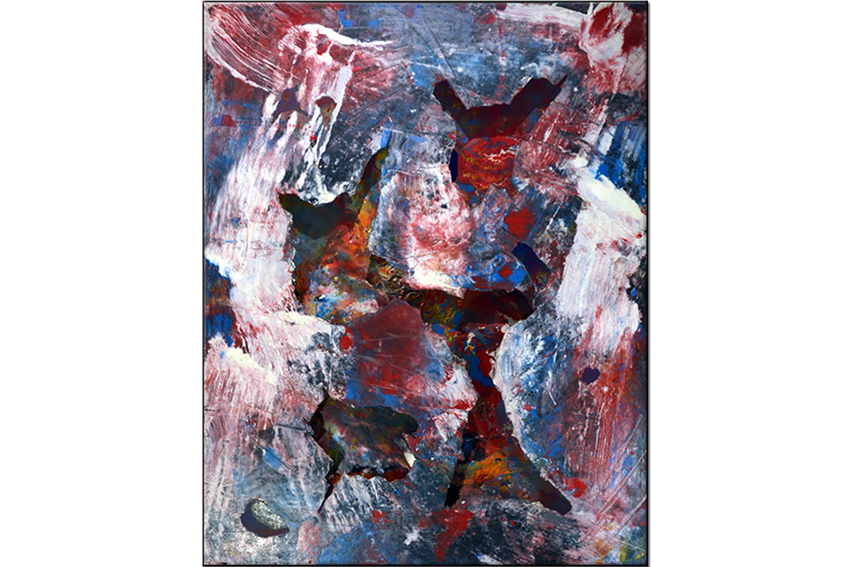
This sarcastically titled split-level work creates multiple experiences of texture and contrast — spatial, tactile and chromatic. Sky-bright interplays of red, white and blue on the outer level surge across a Masonite slab pocked with cavernous holes and scored with deep-scratched gouges. The smooth and seemingly restful space on the inner layer teems with a kaleidoscope of colors, hinting at possibilities even more expansive than those offered above.
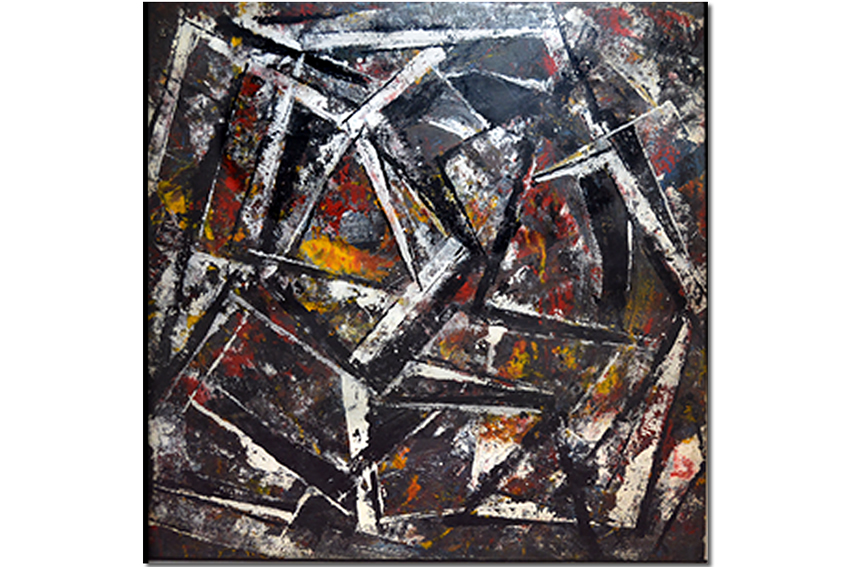
Monochrome “frames” burst apart in a cacophony of lines set against lines, very few of which land at 90 degrees. Blooms of orange and red smolder behind them, lending further intensity to the sense of explosive movement in the foreground. Hard angles everywhere tempt the viewer to search for a comprehensible pattern; instead every nascent form one encounters in this space is caught in a snapshot of its own destruction. One method of approaching this work is to consider it a meditation on the futility of control. Each insistent angle, clear and sensible on its own, only brings more chaos into an already unruly zone of conflict.
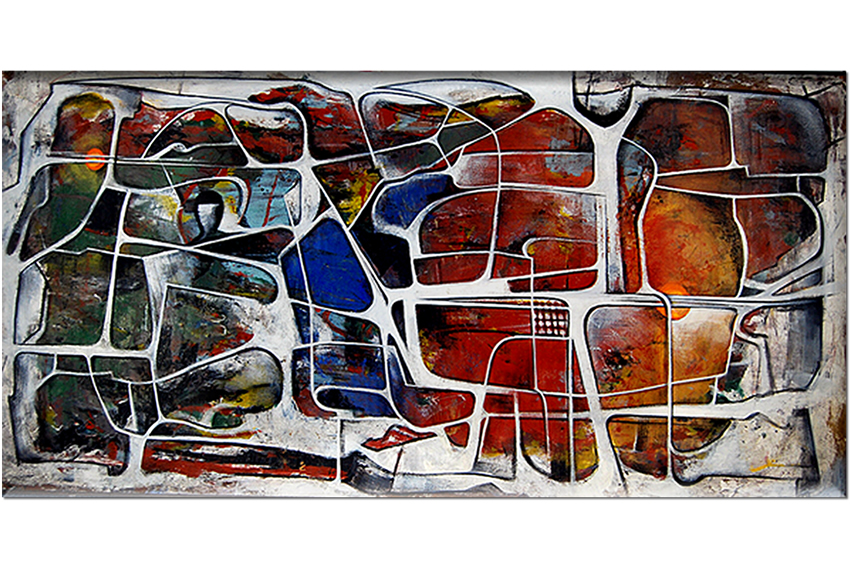
Tristan's favorite among his Paintscape Series. All others in the series were sold. The theme of “point - counterpoint” after which this paintscape is named continues to be explored in depth throughout the work. The sensitivity of his usage of color and the boldness of his linear figurations create an interior landscape which is vast and intricately varied, welcoming the viewer into its depths even as it challenges their perception. It is a composition in dynamic, dialectical conversation with itself, a journey of discovery which is its own reward, in which no easy answers are offered.
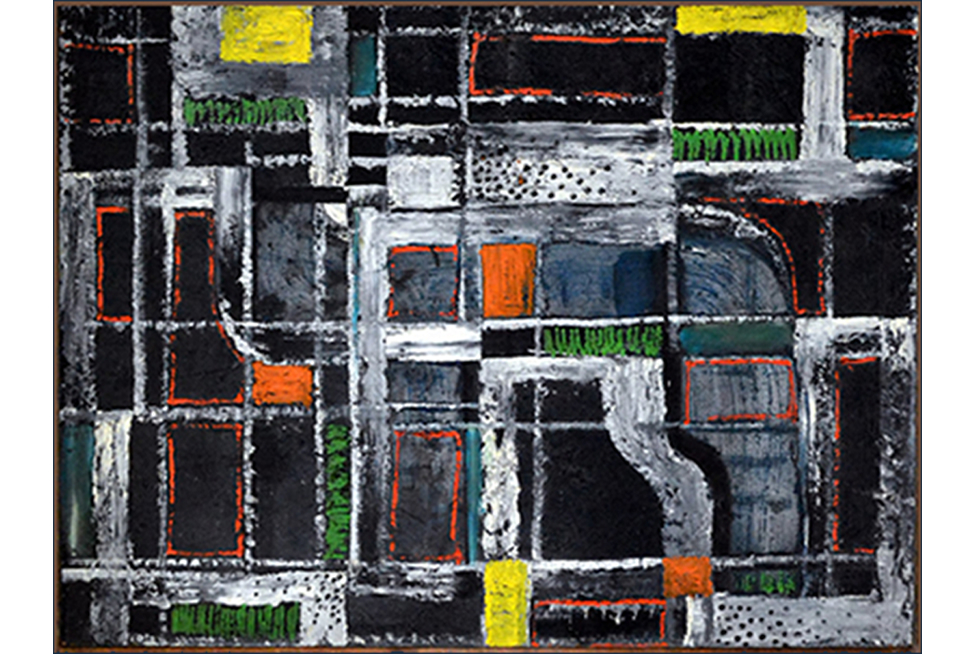
This piece employs mixed-media techniques Meinecke began to experiment with as early as the 1940s. The mixture of concrete, paint and glue used here adds depth and texture not possible with paint alone. He believed art should be not merely seen but interacted with. On his own visits to the Art Institute, he was assigned a guard and eventually banned for refusing to stop trying to touch the works on display. The forms and angles shown here are reminiscent of architectural plans, a discipline in which Meinecke also had a keen interest, designing over 800 units in Lincoln Park with partner Robert Bruce Tague.
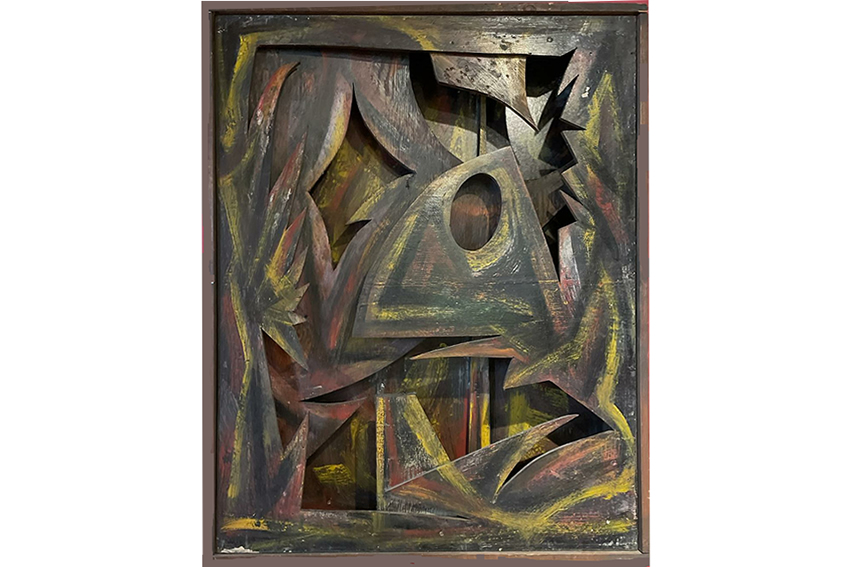
Tristan had an affinity with wood. He was an excellent carpenter who routinely built useful things; workbenches, swing sets, climbing apparatus, and on and on. it was natural that he would construct paintings of wood. For example, Jungle Bird: Warmth and depth, movement and mystery infuse this shadowy construction. Its sharp-angled, abstract forms evoke a sense of vibrant, restless energy. Though the work is undated, it was likely completed in the mid-1960s, as the artist was experimenting with the kinds of complexity he could reveal within multiple intricately cut layers juxtaposed one over the other as if in a forest or jungle.
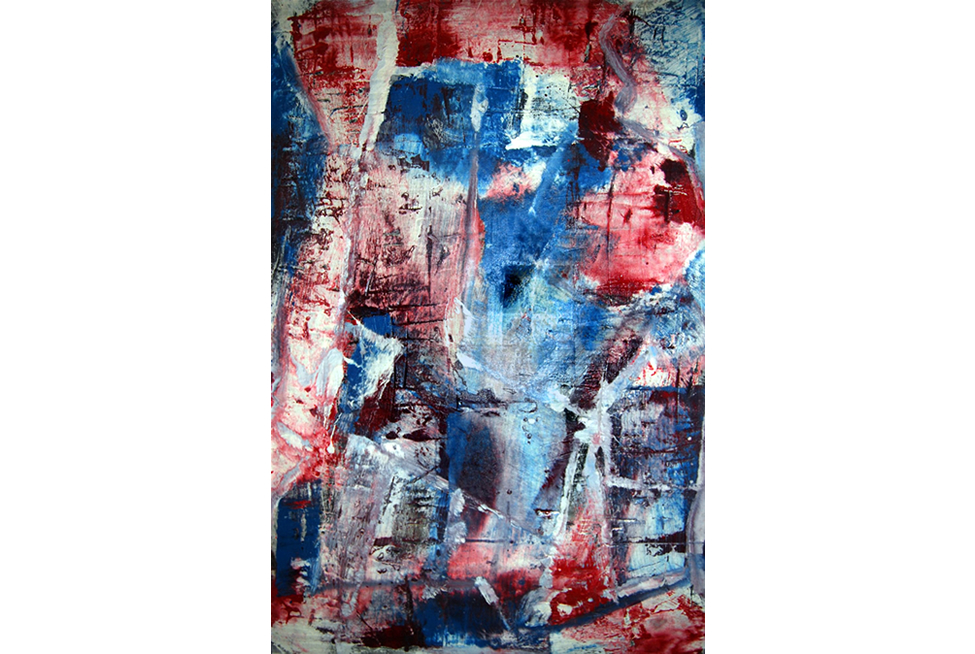
A storm of dynamic movement splays across a once-flat surface, utilizing only red, blue, white and black. Though these techniques are present in other works, this one concentrates on the use of contrasting hues, unexpected brush strokes and the stochastic gouges made on the underlying surface to create a space in which nothing is held still. While one might perceive a pleasing wholeness and a sense of simmering energy within this piece, it cannot be said to have a center, nor any part which predominates over the others. It conveys a potent and focused sense of presence, yet its energy remains numinous, unformed, like a mistrial.
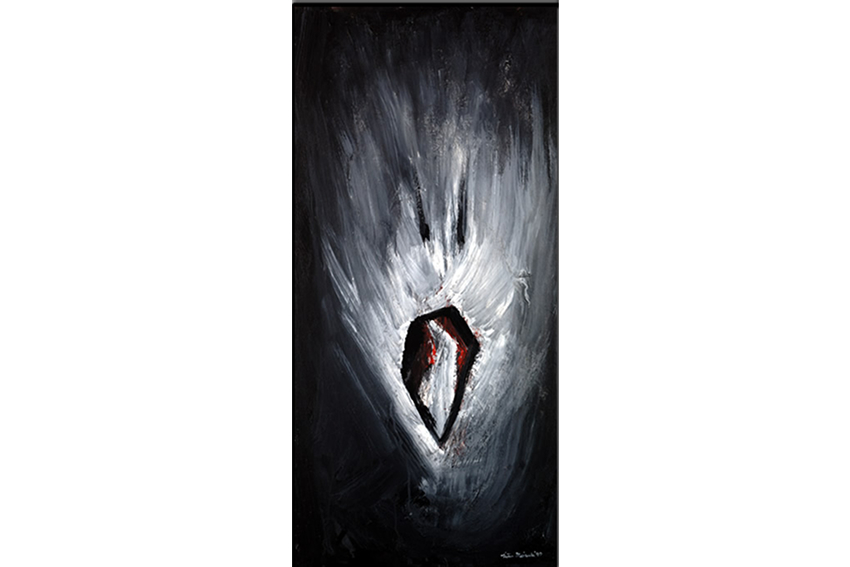
The final work completed by Tristan Meinecke, before he stopped painting two and a half years prior to his death in 2004. Defiance in the face of impending mortality informs this piece; a single splash of red emerges like a roar from an ominous concentration of monochrome swaths. Hurtling into the abyss? The period on Tristan;s final artistic sentence? A random disembodied spirit screaming in rage? If asked he'd likely reply: "Whatever it is to you, it is. Whatever you see within it, is there. Whatever meaning you ascribe to it, is true. Art isn't much until someone views it. It's the viewing that gives it meaning.." Much love from the Meinecke family.